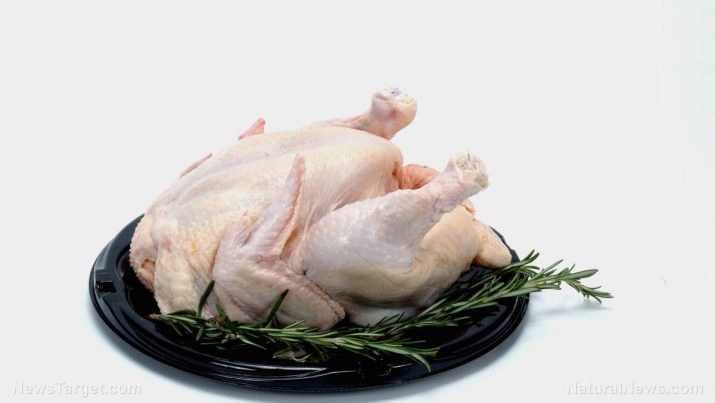
Contaminated chicken: Government looks at farmers, rather than processing plants, for the blame
Wednesday, October 25, 2017 by Janine Acero
http://www.realsciencenews.com/2017-10-25-contaminated-chicken-government-looks-at-farmers-rather-than-processing-plants-for-the-blame.html

Butchers and small-scale farm shops are currently being scrutinized by the Food Standard Agency (FSA) amidst allegations that they are selling chicken contaminated with the food poisoning bacterium Campylobacter, according to a report by The Daily Mail. The FSA has determined 54 percent of chicken sold on High Street (a primary business street market in the U.K.) were contaminated, with 6.5 percent carrying high levels on the skin.
Campylobacter jejuni is one of the key global causes of diarrhoeal illness in humans, particularly gastroenteritis, commonly known as stomach flu. Infection by this bacterium is generally mild, but small children, elderly people and individuals with immunosuppression are highly vulnerable, with infections being potentially fatal. It is found in foods derived from poultry and cattle, when their intestinal tracts had been infected before slaughter. Preventing cross-contamination and using proper cooking methods reduces the risk of infection by this bacterium. (Related: 97 percent of raw chicken is contaminated, but health officials still aggressively target raw milk.)
In the UK, infections by Campylobacter is the leading cause of food poisoning, with 280,000 people succumbing to it each year.
The FSA conducted a year-long investigation, from August 2016 to July 2017, based on 3,980 whole fresh chickens. The figures show that Marks & Spencer’s chickens had the highest overall Campylobacter contamination at 62.7 percent, followed by Asda at 57.1 percent, and Aldi with 56.7 percent. The rest of the figures based on percentage of skin contamination are as follows:
- Lidi – 55.7 percent
- Co-op – 53.0 percent
- Sainsbury’s – 52.8 percent
- Morrisons – 51.1 percent
- Tesco – 46.7 percent
- Waitrose – 38.6 percent
- Others – 71.6 percent
The FSA figures show a decline in the proportion of fresh roasting chicken that carry any contamination – from 74 percent to a still high 54 percent over the past three years. The proportion of skin contamination has dropped from 22 percent to 6.5 percent over the same period.
Since 2014, the FSA has regularly monitored and reported the percentage of contaminated chicken sold by the industry giants, but it has recently announced that it will stop releasing its findings after reaching an agreement with the individual supermarkets to publish their own figures.
The FSA then focused its attention on butchers and small establishments such as farmers markets and small-scale farm shops. Some 71.6 percent carry the bug and 17.1 percent have the highest levels of skin contamination.
FSA chairwoman Heather Hancock said: “The full year’s results from our third annual survey show the significant progress the industry has made in reducing Campylobacter levels in chicken, compared with their starting point.
“The major retailers are now taking on the responsibility to publish their own results, according to a protocol we have agreed. This is a welcome step towards greater transparency.
“Whilst we will keep a close eye on the performance of bigger retailers, it means the FSA can now focus our efforts on smaller establishments, where we haven’t yet seen the same level of improvement and where more progress needs to be made.”
Chicken from farm to table
According to a report by the USDA Food Safety and Inspection Service, these are some of the other bacteria associated with raw chicken:
- Escherichia coli (E. coli) – Commonly found in the intestines of animals and humans. Most strains of E. coli are not harmful, but some can cause digestive problems.
- Listeria monocytogenes – A cause of foodborne illness since 1981, contamination can come from poorly handled food preparation and lack of proper sanitary practices on food storage.
- Salmonella enteritidis – Of the 2,000 kinds of Salmonella bacteria, this is often associated with poultry and egg shells. It may be found in the intestinal tract of warm-blooded animals such as livestock, poultry, dogs and cats.
- Staphylococcus aureus – This bacterium can be carried on human hands or throat and nasal passages. Contamination can come from improperly refrigerated homemade food.
Read more about food safety at FDA.news.
Sources include:
Tagged Under: Tags: agriculture, chemicals, chicken, contamination, farmers, food safety, Food Standard Agency, food supply, FSA, groceries, pesticides, Poultry





